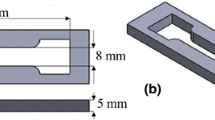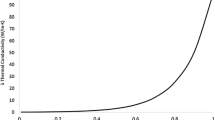Abstract
As additive manufacturing (AM) increasingly gains commercial and academic interest, government agencies, such as NASA Johnson Space Center, seek to produce thermal protection systems using AM methods, such as fused filament fabrication (FFF). The purpose of this study is to develop a suitable polyetherimide (ULTEM™ 1010) nanocomposite with enhanced ablation and thermal properties while maintaining compatibility with commercially available FFF machines. Eleven formulations were compounded using the twin-screw extruder with varying amounts of nanoclay, glass bubbles, and flame-retardant additives. All formulations were characterized via multiple instruments to be down-selected to four candidates for aerothermal testing. After discovering specific characteristics of some formulations, aerothermal test models were 3D printed for four formulations. Enhanced thermal properties among the composite formulations were demonstrated. Aerothermal testing also displayed promising results. In addition to experimental data, microstructural analyses were performed.



(Courtesy of Essentium)

(Courtesy of Essentium)



























Similar content being viewed by others
References
Feldman J, Venkatapathy E, Wilkinson C, Mercer K (2015) Development of an ablative 3D quartz/cyanate ester composite for the orion spacecraft compression pad. https://ntrs.nasa.gov/archive/nasa/casi.ntrs.nasa.gov/20190002016.pdf. Accessed 14 Aug 2019
Graves RA, Witte WG, Langley Research C, United S (1968) Flight-test analysis of Apollo heat-shield material using the pacemaker vehicle system. https://ntrs.nasa.gov/archive/nasa/casi.ntrs.nasa.gov/19680021275.pdf. Accessed 14 Aug 2019
Schellhase KJ, Koo JH, Wu H, Buffy JJ (2018) Experimental characterization of material properties of novel silica/polysiloxane ablative. J Spacecr Rockets 55(6):1401–1413
Golbang A, Harkin-Jones E, Wegrzyn M, Campbell G, Archer E, McIlhagger A (2019) Production and characterization of PEEK/IF-WS2 nanocomposites for additive manufacturing: simultaneous improvement in processing characteristics and material properties. Addit Manuf. https://doi.org/10.1016/j.addma.2019.100920
Kishore V, Chen X, Ajinjeru C et al (2016) Additive manufacturing of high performance semicrystalline thermoplastics and their composites. Solid Freeform Fabr Proc 2016:906–915
Chuang KC, Grady JE, Draper RD, Shin E-SE, Patterson C, Santelle TD (2015) Additive manufacturing and characterization of Ultem polymers and composites. https://ntrs.nasa.gov/archive/nasa/casi.ntrs.nasa.gov/20160001352.pdf. Accessed 8 Oct 2019
Wu H, Sulkis M, Driver J, Saade-Castillo A, Thompson A, Koo JH (2018) Multi-functional ULTEM™1010 composite filaments for additive manufacturing using fused filament fabrication (FFF). Addit Manuf 24:298–306
Braun U, Schartel B, Fichera MA, Jäger C (2007) Flame retardancy mechanisms of aluminium phosphinate in combination with melamine polyphosphate and zinc borate in glass-fibre reinforced polyamide 6,6. Polym Degrad Stab 92(8):1528–1545
Wu H, Ortiz R, Koo JH (2018) Rubber toughened flame retardant (FR) polyamide 11 nanocomposites Part 1: the effect of SEBS-g-MA elastomer and nanoclay. Flame Retard Therm Stab Mater 1(1):25–38
Wu H, Ortiz R, De Correa Renan A, Krifa M, Koo JH (2018) Self-extinguishing and non-drip flame retardant polyamide 6 nanocomposite: mechanical, thermal, and combustion behavior. Flame Retard Therm Stab Mater 1(1):1–13
Wu H, Krifa M, Koo JH (2014) Flame retardant polyamide 6/nanoclay/intumescent nanocomposite fibers through electrospinning. Text Res J 84(10):1106–1118
Samyn F, Bourbigot S, Jama C et al (2008) Characterisation of the dispersion in polymer flame retarded nanocomposites. Eur Polym J 44(6):1631–1641
Greene BR, Clemens NT, Varghese PL, Bouslog S, Del Papa SV (2017) Characterization of a 50 kW inductively coupled plasma torch for testing of ablative thermal protection materials. In: 55th AIAA aerospace sciences meeting. https://doi.org/10.2514/6.2017-0394
Lao SC (2013) Multifunctional cyanate ester/MWNT nanocomposites: processing and characterization. Ph.D. Dissertation, The University of Texas at Austin
Tronvoll SA, Welo T, Elverum CW (2018) The effects of voids on structural properties of fused deposition modelled parts: a probabilistic approach. Int J Adv Manuf Technol 97:3607–3618
Acknowledgements
This work was supported by NASA SAT Award under grant reference #80NSSC18P0735. The authors would like to thank Stan Bouslog and his team at NASA Johnson Space Center for guiding our team throughout this project; Justin Smith, Max Reinert, Christina Cuellar-Nelson, McKenzie Harrison, and Ashlyn Zare for working on this project via the University of Texas at Austin’s Mechanical Engineering Senior Design Project program; Kevin Holder of Essentium, Inc. for preparing the formulations and printing the aerothermal test models; and Benton Green at the University of Texas at Austin’s Aerospace Department for his assistance in operating the ICP instrument.
Author information
Authors and Affiliations
Corresponding author
Ethics declarations
Conflict of interest
The authors of this manuscript report no conflict of interest.
Additional information
Publisher's Note
Springer Nature remains neutral with regard to jurisdictional claims in published maps and institutional affiliations.
Rights and permissions
About this article
Cite this article
Kim, S., Wu, H., Devega, A. et al. Development of polyetherimide composites for use as 3D printed thermal protection material. J Mater Sci 55, 9396–9413 (2020). https://doi.org/10.1007/s10853-020-04676-6
Received:
Accepted:
Published:
Issue Date:
DOI: https://doi.org/10.1007/s10853-020-04676-6




